Our New Billfish: A Rediscovery
Ken Neill, III
published in The Fisherman
When scientists announce the discovery of a new species, we expect it to be from some isolated island or from the depths of the Amazon Rain Forrest. Having one discovered in our own back yard is unusual and we are not talking about some little beetle. We are talking about a large game fish.
Taxonomy is the science of naming and classifying living organisms. They are grouped together based on similar structures and evolutionary origin. With fish, scientist look at a variety of things to establish which organisms are the most similar to each other. They will look at scales, count gill rakers, fin rays and so on. Closely related fish will be grouped into a family. Those in that family which are very closely related will be placed in the same genus. Distinct, breeding populations will be given a species name. Today, the physical characteristics are not the only things which scientists look at. Today they look at genes, the DNA of an organism, to determine how they relate to one another.
Here, in the mid-Atlantic, we have always had five species of billfish to target. The swordfish is the odd man out and exists in its own family. The rest are more closely related and are in the family: Istiophoridae. They are the fairly
common sailfish, white marlin and blue marlin and the much less common longbill spearfish.
Some old-timers would speak of a sixth billfish, the hatchet marlin. This fish looked like a white marlin except that the dorsal and anal fins appeared to have been cut straight across, like with a hatchet. This fish was mostly dismissed as just a white marlin with a fin variant. That is how it has been treated by fisheries managers and by tournament organizers. To them, hatchet marlin have just been white marlin and it turns out that
sometimes, they were correct.
South of us, another Atlantic billfish as been described. This fish was called a roundscale spearfish. This was such a rare catch that next to nothing was known about this possible species. It was believed to be an eastern Atlantic fish.
Dr. John Graves of the Virginia Institute of Marine Science has been studying the DNA of the billfish of the world and some interesting things have been learned. At one time, blue marlin and sailfish from the Pacific and Atlantic Oceans were thought to be different species but molecular genetics shows that there is only one species of sailfish and only one species of blue marlin. Blue marlin and black marlin are not as closely related as once thought.
While looking at the relationships of the various billfish species, they also did a genetic analysis of samples which came from a few fish said to be hatchet marlin. They expected them to type out as white marlin but when they looked at their results, they found that they had a new species on their hands. Furthermore, these fish were much more closely related to the spearfish than to white marlin.
These findings were presented at the Fourth International Billfish Symposium. At this same meeting, Dr. Mahmood Shivji from Nova Southeastern University in Florida, presented the results of his genetic analysis of some samples he was able to obtain of supposed roundscale spearfish. His results indicated that indeed, the roundscale spearfish is a distinct species. The scientists got together and exchanged samples. What they found was that they were looking at a single “new” species with two different common names. Since genetically, it is a type of spearfish, roundscale spearfish is the common name that is being used.
What we know
Not much is known about the life and habits of the roundscale spearfish. It gets large as in white marlin-size large. It is not just an eastern Atlantic species. It is relatively common here in the western Atlantic. Dr. Graves has been collecting DNA samples from every white marlin weighed in at the Mid-Atlantic $500,000 Tournament since 1992. It turns out that the winning white marlin has actually been a roundscale spearfish during a number of those tournaments. Overall, from 1992 through 2006, 18% of the “white marlin” weighed in have actually been roundscale spearfish which shows that these fish are fairly common. It you have done much fishing for white marlin in the mid-Atlantic, you have probably caught a roundscale spearfish. There is a lot left to be learned about our new billfish.
From a management standpoint, there was an immediate concern as to what this would mean with white marlin stock assessments. Did this new fish mean that the abundance of white marlin had been overestimated? Are white marlin in worse shape than we thought? Actually, it probably does not mean much. Since the roundscale spearfish has been counted as white marlin all along, the stock assessments have always been a combined assessment of the two species. At this point, there is no management plan for the roundscale spearfish. If you keep one, expect law enforcement to treat it like a white marlin until proven differently. It may save you some grief if it is long enough to meet the 66-inch minimum lower jaw fork length required for white marlin. The related, longbill spearfish, is illegal to keep at any size.
How do you identify a roundscale spearfish?
Most of us do not have a molecular genetics lab handy so we need a way for the average angler to identify these fish. The most obvious way is by fin shape. This is also the worst way. Though roundscale spearfish do often have the
truncated dorsal and anal fins so can a white marlin. This means that “hatchet marlin” you just caught might be a roundscale spearfish or a white marlin. There are more predictable physical differences between the two species. The scales will look different. The individual scales of a white marlin are not very noticeable where those of the roundscale spearfish are much more distinct with a stippled look. The most sure way of telling them apart is to look at the anal fin and the anal vent. The front edge of the fin and the vent will be about 2 inches apart on a white marlin and about 5-6 inches (about the width of the anal fin) apart on a roundscale spearfish. So if you catch a white marlin that looks a little funny to you, look at the relationship of the fin and vent to see if you have caught a spearfish.
Sidebars:
The Virginia Saltwater Fishing Tournament awards a trophy fish citation for any released spearfish, longbill or roundscale.
Billfish of the World
Family Xiphiidae:
Swordfish: Xiphias gladius
Family Istiophoridae:
Sailfish: Istiophorus platypterus
Black Marlin: Istiompax indica
Blue Marlin: Makaira nigricans
White Marlin: Kajikia albida
Striped Marlin: Kajikia audax
Shortbill Spearfish: Tetrapturus angustirostris
Mediterranean Spearfish: Tetrapturus belone
Roundscale Spearfish: Tetrapturus georgii
Longbill Spearfish: Tetrapturus pfluegeri
(Note: the genus and species names should be italicized)
For more information on the research of Dr. John Graves visit: http://www.vims.edu/about/directory/faculty/graves_je.php

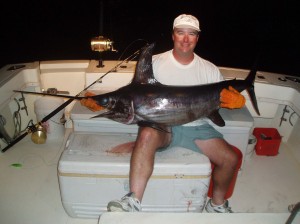
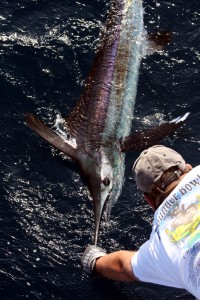
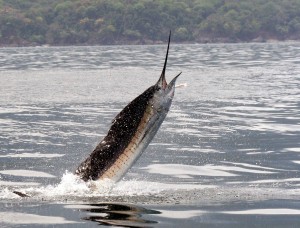
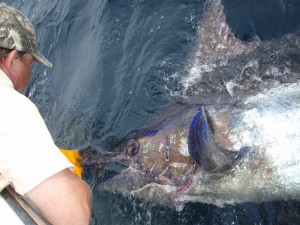
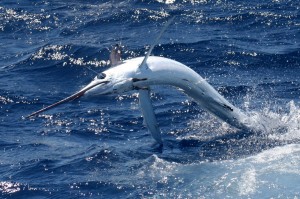

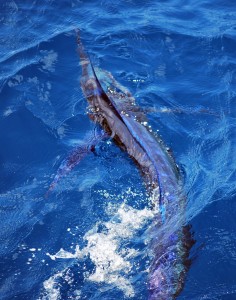
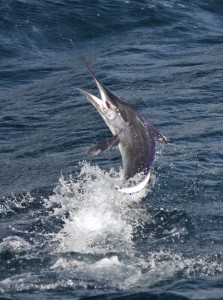
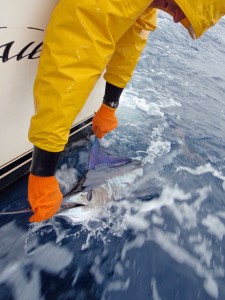
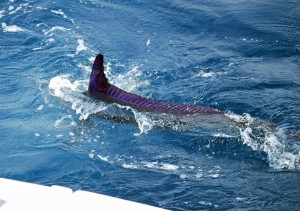

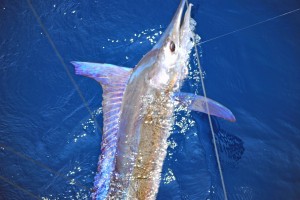

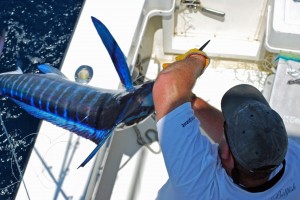

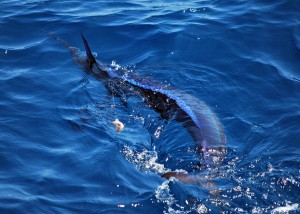
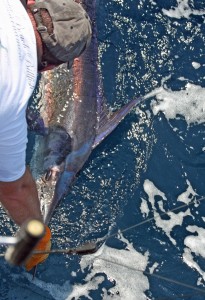
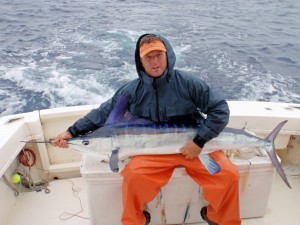

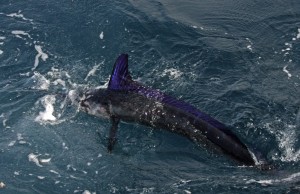
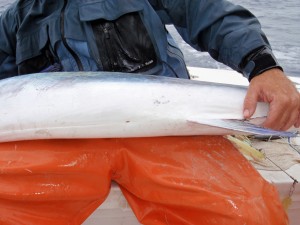

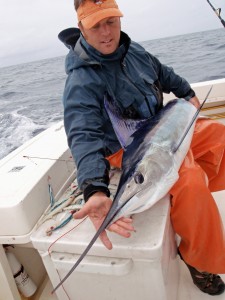
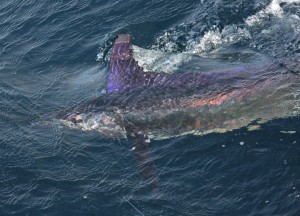
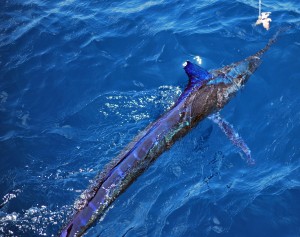
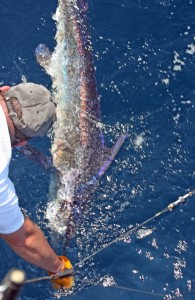
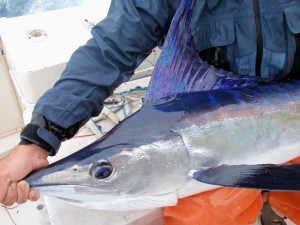
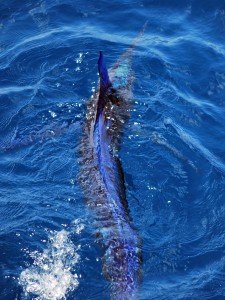

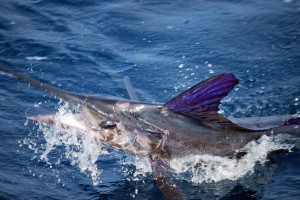
Very intuitive article that was fascinating to read. I have become an avid saltwater angler over the past decade and enjoy the science of the sport almost as much as the catch. I would also like to commend you for publishing such a timely article. It seems that over the past few years the white marling bite has been nothing short of spectacular. With that said, I look forward to being better equiped to deferentiate between the Roundscale and White Marlin.
Keep up the good work!
Regards,
Hayden Bennett